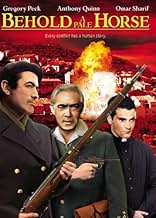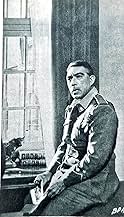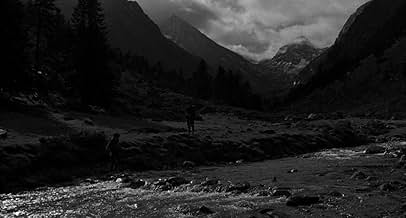NOTE IMDb
6,7/10
2,4 k
MA NOTE
Le célèbre bandit espagnol Artiguez retourne dans son village espagnol natal après 20 ans d'exil en France, mais le flic espagnol Vinolas lui tend un piège.Le célèbre bandit espagnol Artiguez retourne dans son village espagnol natal après 20 ans d'exil en France, mais le flic espagnol Vinolas lui tend un piège.Le célèbre bandit espagnol Artiguez retourne dans son village espagnol natal après 20 ans d'exil en France, mais le flic espagnol Vinolas lui tend un piège.
- Réalisation
- Scénario
- Casting principal
Marietto
- Paco Dages
- (as Marietto Angeletti)
Perrette Pradier
- Maria, Hussy
- (as Perette Pradier)
Avis à la une
I watched this movie, and like most of the people have already expressed it, must say that this is truly a classic. The acting crew is excellent with Peck, Shariff and Quinn giving some very intense performances. But the surprise package is the boy who crosses over to the French part where he goes in search of Manueal to ask him to avenge his father's death at the hands of Vinollas. I often read comments that Peck is stuff or wooden on occasions, but I find him one of the most intense actors because of his ability to convey through his eyes. Like most actors, he is gifted of conveying a lot more through his eyes than his body might suggest. He conveys the frailing Manuel artigez here very well. We know that Manuel is tired and wary of the struggle he has pursued so passionately. Full credit to Peck for portraying that very effectively. Omar Shariff is also brilliant as the confused priest. Quinn is natural and we feel a certain angst against him, I do not know why. The end is excellent which again, conveys the human side of Manuel very well. All in all, an excellent movie worth watching on a calm Sunday afternoon.
There have not been many English-language movies made about the Spanish Civil War, and those that have been made (with the exception of Land and Freedom) tend to shy away from both politics and action, often slow-moving, contemplative affairs. In that vein Behold a Pale Horse, based on a novel by Hungarian screenwriter Emeric Pressburger, is a meditation on loyalty, trust and faith, not in religion but in religious institutions and individuals. The Spanish Civil War, or rather its aftermath, are the backdrop for these themes. But despite this ruminating premise the picture just about manages to save itself from terminal dullness.
A lot of this has to do with director Fred Zinnemann. Zinnemann was not exactly a dynamic director but he had a certain way of drawing us into a story and holding our interest. During the opening credits his camera tracks along a line of nameless faces, encouraging us to look over every line and notice every blink, introducing a quietly human picture. And yet he is also placing people within their context, showing young Paco dwarfed amid the houses of Pau, mirroring the mountains from which he has descended, or panning down from the figure of Christ to a reverent Anthony Quinn (shades here of Zinnemann's other Christian-themed pictures A Nun's Story and A Man for All Seasons). Above all Zinnemann is a master of tension without over-manipulation. Events seem to unfold in real-time, with a sprinkling of point-of-view shots to draw us into the unfolding action.
It is interesting to see Gregory Peck and Anthony Quinn playing the hero and villain. Both men are possessed of dark hair and sharp, stony features. Both have a stern bearing and charismatic presence. One can imagine them playing brothers; a good twin and a bad twin perhaps. They are both very good here, but the best performance I feel belongs to Omar Shariff, grappling with some kind of a conscience, refusing to make the meek priest into a stereotype. Italian character actor Paolo Stoppa, familiar from a lot of European co-productions, is very good too. Finally, watch out for a brief but typically mesmerising bit part by Rosalie Crutchley as Quinn's wife.
A strong cast and thoughtful direction are enough to keep this picture moving. Also of note is the Maurice Jarre score. This was by now an era in which you didn't have to have a blaring orchestral score (and thankfully those irritating free jazz scores of the late 50s were going out of style). Behold a Pale Horse features sparse and staccato Spanish guitar, fitting for both the location and the nervous and somewhat melancholic story. This is far from being a war movie, but it is a picture of great solemnity, atmosphere and touching humanity.
A lot of this has to do with director Fred Zinnemann. Zinnemann was not exactly a dynamic director but he had a certain way of drawing us into a story and holding our interest. During the opening credits his camera tracks along a line of nameless faces, encouraging us to look over every line and notice every blink, introducing a quietly human picture. And yet he is also placing people within their context, showing young Paco dwarfed amid the houses of Pau, mirroring the mountains from which he has descended, or panning down from the figure of Christ to a reverent Anthony Quinn (shades here of Zinnemann's other Christian-themed pictures A Nun's Story and A Man for All Seasons). Above all Zinnemann is a master of tension without over-manipulation. Events seem to unfold in real-time, with a sprinkling of point-of-view shots to draw us into the unfolding action.
It is interesting to see Gregory Peck and Anthony Quinn playing the hero and villain. Both men are possessed of dark hair and sharp, stony features. Both have a stern bearing and charismatic presence. One can imagine them playing brothers; a good twin and a bad twin perhaps. They are both very good here, but the best performance I feel belongs to Omar Shariff, grappling with some kind of a conscience, refusing to make the meek priest into a stereotype. Italian character actor Paolo Stoppa, familiar from a lot of European co-productions, is very good too. Finally, watch out for a brief but typically mesmerising bit part by Rosalie Crutchley as Quinn's wife.
A strong cast and thoughtful direction are enough to keep this picture moving. Also of note is the Maurice Jarre score. This was by now an era in which you didn't have to have a blaring orchestral score (and thankfully those irritating free jazz scores of the late 50s were going out of style). Behold a Pale Horse features sparse and staccato Spanish guitar, fitting for both the location and the nervous and somewhat melancholic story. This is far from being a war movie, but it is a picture of great solemnity, atmosphere and touching humanity.
I get surprise when see that only a few people see this film because I think that it is one of the best zinnemann film.The story which is about alone man that is far from of best years of his life and right now is desolate and subsist in very hard condition(spiritual)is so nice.Peck,Quinn and Sharif all are in their best. Scene that vinolas(Quinn)pray in church is unforgettable.
When the Spanish War was finished, winners devoted to go after anybody who reflected the red light of the communism or any other color they dislike. On the other hand, few guerilla fighter continued his actions against the winners. But their strength was lower every time. One of this guerrilla was Valentin González "el campesino", which figure is portrayed in this film in a free form (not in an historical form).
Twenty years after the Civil war conclusion, the Spanish police has a good option to capture one of these ex-combatants, who was in exile in France. The description of the methods and day-to-day life of the Spanish police could be the reason which explains that the Spanish Government forbade any more Columbia's film in Spain.
You need no knowledge about the twenty Century Spain's history to understand the film, although you can enjoy more it if you know something. In fact, the film put in a specific political situation the psychological confrontation between two men. It could be a good exercise to understand the motives which impulse his actions.
Twenty years after the Civil war conclusion, the Spanish police has a good option to capture one of these ex-combatants, who was in exile in France. The description of the methods and day-to-day life of the Spanish police could be the reason which explains that the Spanish Government forbade any more Columbia's film in Spain.
You need no knowledge about the twenty Century Spain's history to understand the film, although you can enjoy more it if you know something. In fact, the film put in a specific political situation the psychological confrontation between two men. It could be a good exercise to understand the motives which impulse his actions.
This is a film which has almost faded into total obscurity, and that's tragic, because it's well worth seeing. It's sort of a thinking person's suspense movie, better appreciated if you know some details about the intricate historical background in which it is set. Even so, it can be appreciated for its dramatic settings and characterizations. It has a complicated plot, to be sure, but the story rolls right along...not a lot of action until the end, but the tension builds steadily. I'm no fan of Peck, but his role here really drew me in. He looks beaten down by a hard life and way too much unhealthy passion. Quinn doesn't have much screen time, but I liked some of the minor characters best...their faces were great. The credit sequence, meshed together perfectly with newsreels, shows a long line of defeated soldiers, their faces reflecting defeat and confusion... a great tracking scene.
Here are some reasons I think the film is unknown: 1. The main character is an atheist communist anti-catholic guerilla bandit. Not a popular icon in American movies. 2. Complex historical background. 3. Knowledge of political situation in Spain a minimum requirement. Not a priority on many American's lists. 4. Black and white photography in 1964. (Hey, I liked the scenery...but you always wonder how it would look in color...and this was a late date for a black and white feature film.) 5. Civil War movies (even Spain's) always run a risk...you might alienate half the audience.
Here are some reasons I think the film is unknown: 1. The main character is an atheist communist anti-catholic guerilla bandit. Not a popular icon in American movies. 2. Complex historical background. 3. Knowledge of political situation in Spain a minimum requirement. Not a priority on many American's lists. 4. Black and white photography in 1964. (Hey, I liked the scenery...but you always wonder how it would look in color...and this was a late date for a black and white feature film.) 5. Civil War movies (even Spain's) always run a risk...you might alienate half the audience.
Le saviez-vous
- AnecdotesThe movie was banned in Spain, which was still ruled by Generalisimo Francisco Franco, the fascist victor of the Spanish Civil War.
- GaffesIn the first 5 minutes of the movie it is supposed to be 1939 and the Loyalist (Republican) soldiers are crossing into exile on the French border. As they cross over they are turning in their guns and the first one to turn in his gun turns in a Soviet PPSh-41 sub-machine gun. The PPSh-41 was not developed until 1941.
- Crédits fousOpening credits - the first card shown contains the passage from Revelations 6:8, which contains the phrase "Behold a Pale Horse", the title of the film.
- ConnexionsFeatured in Hollywood contra Franco (2008)
Meilleurs choix
Connectez-vous pour évaluer et suivre la liste de favoris afin de recevoir des recommandations personnalisées
- How long is Behold a Pale Horse?Alimenté par Alexa
Détails
Box-office
- Budget
- 3 900 000 $US (estimé)
- Durée2 heures 1 minute
- Couleur
- Mixage
- Rapport de forme
- 1.85 : 1
Contribuer à cette page
Suggérer une modification ou ajouter du contenu manquant

Lacune principale
By what name was Et vint le jour de la vengeance (1964) officially released in India in English?
Répondre



































